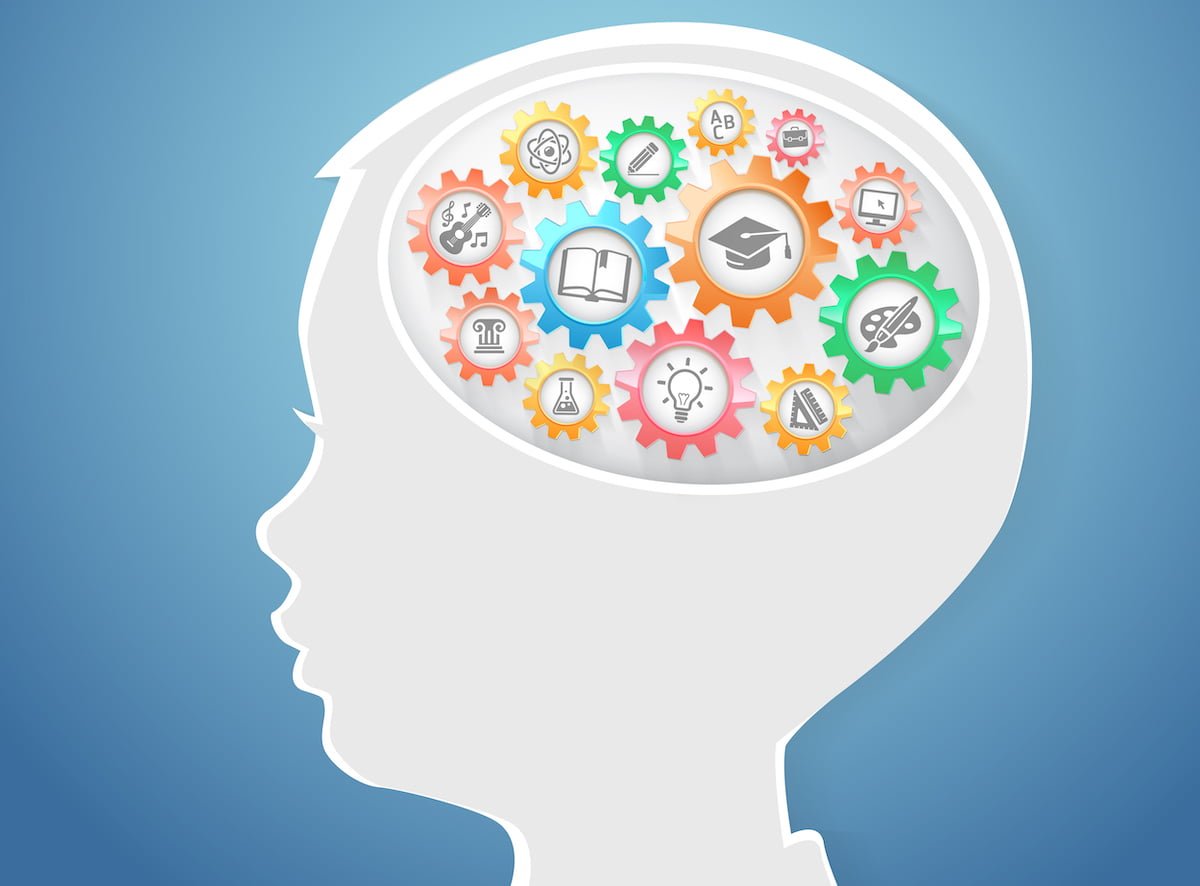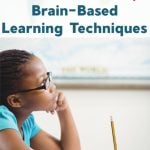Brain-Based Learning: What It Is and How To Apply It
Brain-based learning is a philosophy that uses neuroscience, psychology, and education to holistically support the learning process. Find out how to use it to enhance student learning at school or home.

Being in education for more than 15 years, I have long learned to appreciate the idea of brain-based learning. It is simply a school of thought that encourages instructors to teach based upon the development and the cognitive needs of students.
What is Brain-Based Learning?
Brain-based learning encompasses teaching methods, lesson plans, and school programs that are based on scientific research about how the brain learns. It includes factors such as
- cognitive development
- how in different classroom environments, students learn differently
- how students’ attention, learning, and behavior styles change as they grow or mature
- the social and emotional aspects of learning
Brain-based learning centers around neuroplasticity, or the remapping of the brain’s connections when learning new concepts.
“Brain-based learning is motivated by the general belief that learning can be accelerated and improved if educators base how and what they teach on the science of learning, rather than on past educational practices, established conventions, or assumptions about the learning process.”
“For example, it was commonly believed that intelligence is a fixed characteristic that remains largely unchanged throughout a person’s life. However, recent discoveries in cognitive science have revealed that the human brain physically changes when it learns, and that after practicing certain skills it becomes increasingly easier to continue learning and improving those skills.”
“This finding—that learning effectively improves brain functioning, resiliency, and working intelligence—has potentially far-reaching implications for how schools can design their academic programs and how teachers could structure educational experiences in the classroom.” (source)
Keeping in mind the diverse concept of brain-based education, it may take a wide variety of forms depending upon the goal of the teacher and the needs of the classroom. Lessons may be designed to reduce stress or to eat healthy, both which are factors that affect learning. (edglossary.org, 2013)
In 1994, research by Geoffrey Caine and Renate Nummela Caine’s concluded that students taught in a brain-based teaching environment showed increased retention and understanding. Since then, more schools adopted this teaching method.
As a parent, I have come to embrace this practice even more as I navigate the joys of parental instruction of my child. It certainly makes for a less stressful process.
What Brain-Based Learning Isn’t
We are living in an age of product and result. What’s the bottom line? Let’s get an outcome…quickly! Our educational system joined in decades ago with test-obsessed curricular and feeling pressured to concretely measure what students know.
There’s one thing brain-based learning isn’t – a way to improve intelligence test scores. According to Cognition Today:
“This does not mean that brain-based learning cannot make people smarter, it only expects that as an outcome. Some of the aspects involved in intelligence such as working memory, attention, long-term memory, verbal fluency, are likely to improve due to the use of specialized techniques.”
Brain-Based Learning Principles
That is certainly the cornerstone of learning; the actual process. This process can only be attained if we go back to embrace the idea of understanding how the brain works and how individual children take in information.
In learning to fulfill the needs of our children’s brains, understanding our own modality of learning is important, because how we learn often affects how we teach.
Here’s how we can apply these learning principles and insights:
- Engaging the whole body with breaks for movement and physical activity
- Offering positive reinforcement for mastering new concepts
- Using storytelling or humor to stimulate more parts of the brain
- Arranging group projects where students can teach and learn from their peers
- Avoiding long lectures – Only 5-10% of information imparted during a lecture is retained after just one day. Discussion is a more effective way of ensuring retention. (source)
- Moving information from short- to long-term memory
- Reducing stress in the learning environment
- Modeling assignments on real-world challenges students experience.
Here’s an example.
Because I process new information best via reading, discussion and taking notes, much of my earlier lessons in the classroom focused on this strategy. Written words have always made me comfortable and without realizing it, I formulated the majority of my lesson design in such a way that was most convenient for me.
Once I became aware of this, I focused on discovering how my students’ brains worked and shaped the lessons and assignments accordingly. Their learning immediately became more enriched. Learning the way we best take in information is only an initial step, however. Appreciating the season in which the human brain is ready to receive is also important.
When I think back to grade school, I often wonder why it took me longer to understand specific mathematical concepts and then perhaps a year later, they were so clear. While the type of instruction could be a factor, I believe much of it had to do with brain development.
The Brain “Gets It” When It Gets It
Most experts agree that growth and learning comes from both nurture and nature.
While parents and teachers clearly must expose young learners to ideas and allow them to have various experiences, i.e. nurture, there are many skills such as crawling, walking, and talking that they will do naturally as their brains develop, i.e. nature.

This is a concept that I work diligently to apply to my instructional and parental toolbox when it comes to brain-based learning. It’s not always easy because it’s more comfortable to believe that learning is simply linear: The information goes in and out comes the product or the result.
That isn’t the case of course, for anyone. Nature, which includes our cognitive wiring, our emotions and personality, can actually drive the type of nurture that a child needs.
How to Apply Brain-Based Learning Strategies
So although it takes my daughter a bit longer to complete nightly reading because while exercising her need for kinesthetics, she acts out each scene within the plot of the story, I allow it. Sometimes, she even dons costumes and renames the characters which adds on another 25 minutes, but we get through the book and her brain is happy.
Let’s keep nurturing our children’s brains by exposing them to amazing things, giving them what they need and allowing it all to soak in.
Let’s celebrate their wins and losses and watch them thrive. The knowledge is there and when we listen, it spurts out daily.
And finally, let’s let ourselves off the hook. We set such amazing expectations of what we want our children to do, know, and in what manner. This can be a good thing. But I don’t want to miss years of enjoying my child develop organically and witness the miraculous growth of her beautiful mind.


Please forgive my error. I meant fallacy, not facility.
Hi Ahjirasa,
Thanks so much for sharing your thoughts! I agree that this is an ideal learning model for those whom are being home schooled. The facility unfortunately, with the opinions of most instructional styles is the belief that they cannot be implemented within many learning climates; which is not accurate. While every strategy may not be the best fit for a classroom or a learning situation, it is up to the instructor to find what works best for their classroom based upon student needs domestically or abroad. One should take this article as an opportunity to search the gitts and needs of their own children and students in order to learn how to best serve them.
I feel I need to comment, so please bear with me.
I think this type of learning will most benefit those whose children learn at home (homesch) vs at school. Because on a sch setting, with 30 students in a classroom, a teacher cannot tailor to each child. However, at home, each parent can enhance what their student learned at school, by going over the lessons and allowing their child to grasp it in a manner that suits that child’s developing brain the best.
Also, realize that this magazine is read by those not living in countries other that the US. This is of course, excellent news. The downside is that some of the articles, such as this one, offer ideas that many parents just aren’t equipped to use. It would be wonderful if the writers would be made aware and they can start thinking more globally in their approach to education and benefiting the education community. Because our world needs everyone up on the stage in order to turn this slowly rotting world back to being green and verdant again.
Thank you for listening:)
An American mom, leaving abroad (very happily)
I absolutely LOVE Paula’s article. It addresses the misnomer that learning is a robotic process and should only be results-oriented. My sister and really the entire family are on this journey of figuring out how my niece learns best. And it is stressful because one can’t help but compare and worry about output. But this article helps one remember that enjoying the process of watching a little one learn at their own pace is soo important – especially since it will help remind us
and show the youngster that learning is a beautiful thing. I love this article!
Thank you! Yes, please enjoy your niece’s journey.
Paula’s article was right on point. Teachers and parents tend to teach as they were taught, and that’s not always suitable for all children. I, too, taught as the facilitator, and fortunately, it proved successful. But just think of how much more students who were not auditory learners might have absorbed, had other modalities been addressed?
In the latter years of my career, I gave an inventory that enabled me to determine whether my middle school students were visual, auditory, or kinesthetic learners, and what a difference that made! I even discovered my granddaughter was a kinesthetic learner who used her sense of touch, and employed graphic organizers, etc, This well-written article will help others to recognize differences, teach acccordingly, and applaud those differences.
This research will help all educators and parents instruct their children accordingly, Great information!
Thanks so much, Mrs. Lindsey! It’s so great to hear from you.